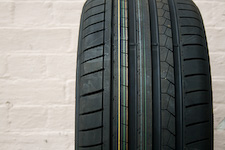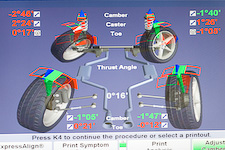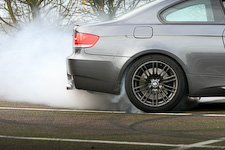Tyre Care and Tyre Life
 Tyres are consumable items, they wear during normal use and have a useful service life. With that in mind you might think tyres don't need much attention, but how you treat your tyres can drastically increase, or reduce the tread life. Current law requires that car tyres must have a minimum of 1.6mm of tread in a continuous band throughout the central ? of the tread width over the entire circumference of the tyre. Tyres have wear markers at regular intervals in the grooves of the tread - once the main surface of the tyre is level with these markers it is time to replace your tyre.
Tyres are consumable items, they wear during normal use and have a useful service life. With that in mind you might think tyres don't need much attention, but how you treat your tyres can drastically increase, or reduce the tread life. Current law requires that car tyres must have a minimum of 1.6mm of tread in a continuous band throughout the central ? of the tread width over the entire circumference of the tyre. Tyres have wear markers at regular intervals in the grooves of the tread - once the main surface of the tyre is level with these markers it is time to replace your tyre.
Fortunately there are many ways you can increase the life of your tyre and with a few weekly checks you can ensure you get the maximum from your expensive rubber.
Tyre pressures
Tyre pressures should be checked weekly, when the car has been standing for at least an hour to ensure the tyres are cool. Under inflation can cause excessive wear on the outside of the tyres, heat build up in the shoulders and even sudden deflation (blowout) at speed. Over inflation causes excessive wear down the centre of the tyres tread shortening the tread life.Alignment
 Alignment is a general term covering toe, camber and castor.
Alignment is a general term covering toe, camber and castor.
Toe is how parrallel the wheels are if viewed from above. Usually cars have neutral toe, or a little positive toe to help straight line stability. If toe is out of alignment the inside or outside of the tyres will wear extremely quickly.
Camber is how much the tyres lean inwards from bottom to top. Like toe, too much negative or positive camber can cause excessive tyre wear and upset the handling of your car.
Balancing
Wheel balancing might not increase the life of your tyre, but it can help increase the life of your suspension components. When a wheel / tyre is out of balance you will feel it as a vibration at certain speeds either through the steering wheel, or through the car itself. A quick visit to your local garage to have the tyres rebalanced will usually cure this.Other causes of excessive tyre wear:
Driving style
 How you drive your car can have a massive impact on tyre wear. A tyre that would last over 20,000 miles if driven carefully up and down motorways could quite easily be on the wear blocks in 2,000 miles if slid around every roundabout you encounter!
How you drive your car can have a massive impact on tyre wear. A tyre that would last over 20,000 miles if driven carefully up and down motorways could quite easily be on the wear blocks in 2,000 miles if slid around every roundabout you encounter!







